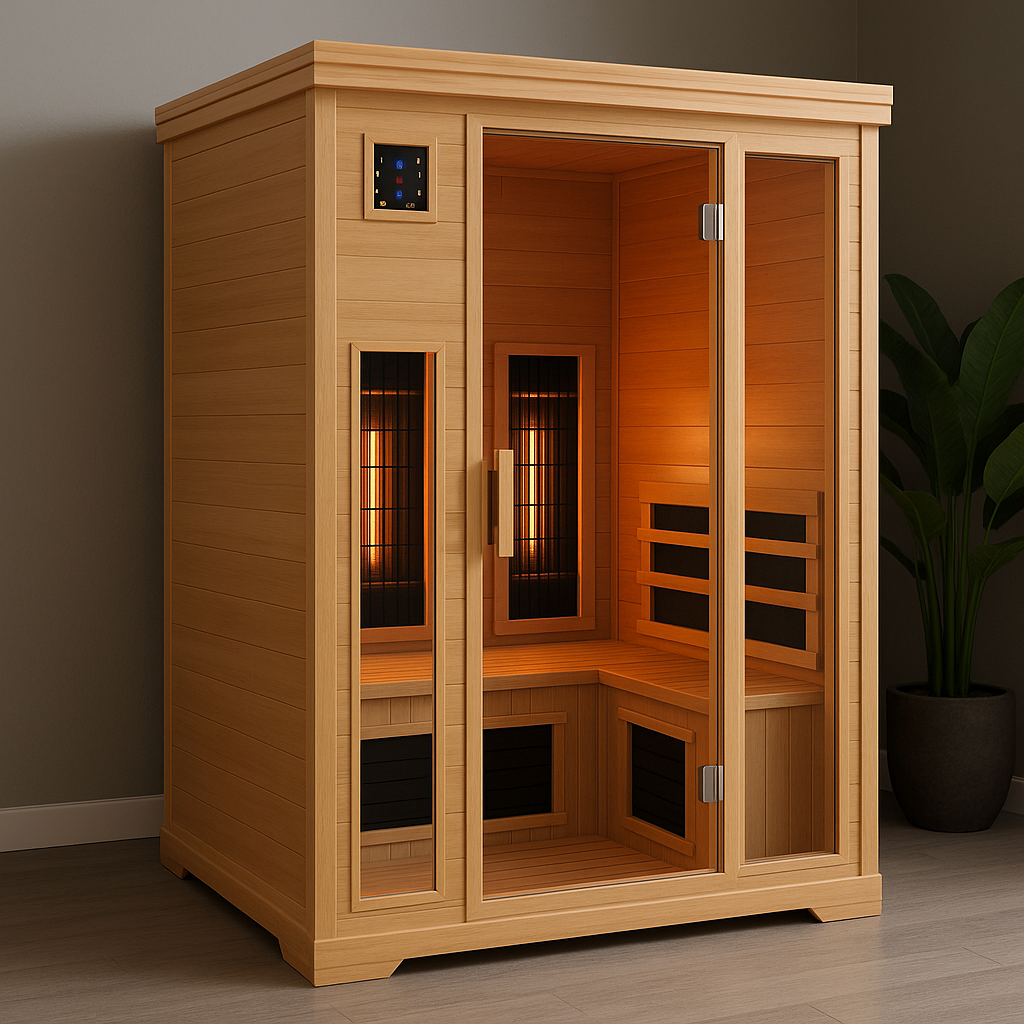How Long Should You Stay in a Sauna? What to Know About Sauna Duration
Finding the Right Sauna Time for Maximum Benefits
For many, saunas are a relaxing retreat that promises numerous health benefits—from detoxification to enhanced circulation. However, how long should you actually stay in a sauna to get the most out of your session? The right amount of time can vary depending on the type of sauna, your personal health, and your goals for the session. While it may seem simple to just relax and enjoy the heat, overdoing it or not spending enough time can limit the benefits.
In this comprehensive guide, we'll answer the question, "How long should you stay in a sauna?" We'll break down the ideal sauna time for different sauna types, including infrared and traditional saunas, and provide expert advice for maximizing the health benefits of your sauna session. Whether you’re using the sauna for muscle recovery, detoxification, or stress relief, understanding the proper duration will help you get the most out of your experience.

What’s the Ideal Sauna Time for Beginners?
If you're new to saunas, it's important to start slow and gradually build up your tolerance to heat. For first-timers, the recommended sauna duration is between 5 to 10 minutes. This shorter duration allows your body to adjust to the heat without overdoing it.
Why Start Slowly?
- Heat Tolerance: If you’re not used to the heat, starting with a shorter session helps you gauge how your body reacts.
- Hydration: The heat causes you to sweat, which can lead to dehydration if you’re not careful. It’s essential to stay hydrated before and after your sauna session.
- Comfort Level: Every person’s heat tolerance differs, so it’s best to listen to your body. If you feel dizzy, lightheaded, or uncomfortable, it's time to exit.
As you become more accustomed to the sauna, you can gradually increase your time. For most regular sauna users, 15 to 20-minute sessions in traditional saunas are common. For infrared saunas, the time can often be longer because the heat is less intense.
How Long Should You Stay in a Traditional Sauna vs. Infrared Sauna?
The duration for sauna sessions can vary significantly between traditional and infrared saunas, largely due to the differences in the way heat is delivered.
Traditional Saunas:
These use hot rocks or an electric heater to warm the air. As a result, the air temperature can reach 180-195°F (82-90°C). The heat can feel intense, so a typical session should last between 15 and 20 minutes. Staying beyond this can lead to overheating, so it’s crucial to monitor your comfort level.
Infrared Saunas:
Infrared saunas use infrared light to directly heat your body, rather than the air around you. This allows for a gentler experience, with temperatures usually between 120-140°F (49-60°C). As infrared heat penetrates deeper into the body, you can generally stay in the sauna for 20–30 minutes, making them ideal for longer, more relaxing sessions.
When to Choose Each Type
- Traditional Sauna: Best for a high-intensity heat experience and short, powerful detox sessions.
- Infrared Sauna: Ideal for longer sessions focused on muscle recovery, detoxification, and skin health.
How Long Should You Stay in the Sauna After a Workout?
Sauna sessions after a workout can enhance muscle recovery and promote relaxation. The heat helps relax tense muscles and increases blood flow, which speeds up the recovery process.
Recommended Duration:
15 to 20 minutes post-workout.
Why Use a Sauna After Exercise?
- Muscle Relaxation: Heat helps reduce muscle stiffness and soreness.
- Increased Circulation: Heat promotes blood flow to muscles and joints, speeding recovery.
- Stress Relief: Post-workout saunas reduce cortisol and boost endorphins, helping you unwind.
💡 Tip: Avoid jumping into a sauna immediately after heavy cardio. Let your heart rate settle first for safety.
How Long Can You Safely Stay in a Sauna?
While saunas offer many benefits, staying too long can have the opposite effect. The general safe range is:
- Traditional sauna: 15–20 minutes
- Infrared sauna: 20–30 minutes
Factors That Affect Safe Sauna Duration:
- Your hydration level
- Sauna temperature
- Your fitness and health condition
- If you’re pregnant, have low blood pressure, or have heart conditions, consult a physician before sauna use.
Signs You’ve Stayed Too Long:
- Dizziness or nausea
- Unusual fatigue
- Headache
- Irregular heartbeat
Exit the sauna immediately and hydrate if you feel any of the above.
How to Maximize Your Infrared Sauna Session
Infrared saunas are known for their gentle heat and deep tissue benefits. To get the most out of your infrared sauna session, here are some pro tips:
1. Hydrate Before, During, and After
Infrared heat makes you sweat a lot, so drink water or electrolytes like coconut water before and after.
2. Dress Right
Wear light clothing or go in nude if possible (depending on the setting). Avoid tight clothes that restrict sweat flow.
3. Create a Routine
For optimal benefits, aim for 3–4 sessions per week, 20–30 minutes each.
4. Use Aromatherapy or Music
Boost relaxation with essential oils like eucalyptus or calming music.
5. Cooldown Time
Allow at least 5–10 minutes to cool down before showering to stabilise your internal body temperature.
Frequently Asked Questions
Can I use a sauna every day?
Yes, daily use is safe for most healthy adults, especially infrared saunas. Just monitor hydration and duration.
Is it safe to sleep in a sauna?
No. Sleeping in a sauna is dangerous due to the risk of overheating and dehydration.
Can I bring my phone inside?
Avoid bringing electronics unless they are rated for high heat and humidity.
Can children use saunas?
Children can use saunas but for much shorter durations (5–10 minutes) and at lower temperatures. Always with adult supervision.
Additional Ways to Enhance Your Sauna Routine
- Contrast Therapy: Alternate sauna sessions with cold showers or cold plunges to stimulate circulation and promote recovery.
- Breathing Exercises: Practice deep breathing or box breathing to amplify relaxation and oxygenation.
- Add Sauna Accessories: Wooden headrests, backrests, and towels enhance comfort. Use a timer to track your session safely.
The Role of Sauna Time in Wellness Goals
Let’s connect specific sauna durations to wellness goals:
| Goal | Sauna Type | Duration |
|---|---|---|
| Detoxification | Infrared | 20–30 minutes |
| Stress Relief | Infrared/Traditional | 15–30 minutes |
| Muscle Recovery | Infrared | 20–30 minutes post-workout |
| Skin Health | Infrared | 25–30 minutes |
| Cardiovascular Benefits | Traditional | 15–20 minutes |
Key Benefits of Sauna Sessions and How Duration Plays a Role
-
Detoxification
Sweating for 20–30 minutes allows your body to eliminate toxins like heavy metals and environmental pollutants. -
Improved Circulation
The heat expands blood vessels, improving heart health and oxygen flow to muscles and organs. -
Stress Reduction
A 15-minute sauna session triggers endorphins and decreases cortisol—great for mental wellness. -
Skin Health
Regular sessions unclog pores, remove dead skin, and improve circulation to the skin’s surface. -
Better Sleep
Evening sessions help regulate melatonin and body temperature, promoting deep sleep.
Conclusion: Finding Your Ideal Sauna Time
The amount of time you should spend in the sauna depends on your goals, the type of sauna, and your comfort level. While traditional saunas typically require shorter sessions due to the high heat, infrared saunas allow for longer sessions due to their gentler warmth. No matter which type of sauna you choose, it's essential to listen to your body and stay hydrated throughout your session.
If you're looking to experience the full benefits of sauna use, consider how long you're spending in the sauna and the type of sauna that best suits your needs. Adjust your routine based on your wellness goals—whether it's stress relief, muscle recovery, or detoxification.
Additional Resources
Here are credible resources to dive deeper into sauna science, safety, and wellness:
- PubMed Study on Cardiovascular Effects of Sauna
- Mayo Clinic: Do Infrared sauna have health benefits?









Leave a comment
This site is protected by hCaptcha and the hCaptcha Privacy Policy and Terms of Service apply.